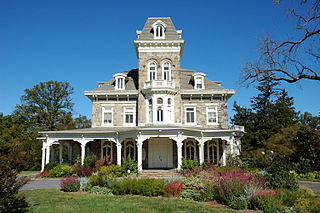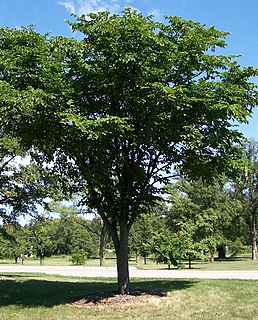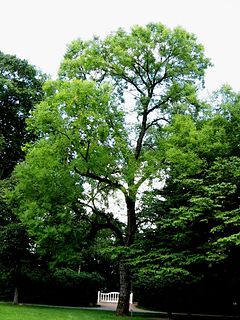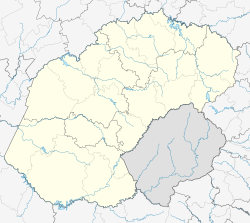
An arboretum in a general sense is a botanical collection composed exclusively of trees. More commonly a modern arboretum is a botanical garden containing living collections of woody plants and is intended at least in part for scientific study.

Washington Park is a public park in Seattle, Washington, United States, most of which is taken up by the Washington Park Arboretum, a joint project of the University of Washington, the Seattle Parks and Recreation, and the nonprofit Arboretum Foundation. Washington Park also includes a playfield and the Seattle Japanese Garden in its southwest corner. The entire length of Arboretum Creek is within the park.

Harcourt is a commune in the Eure department in the Normandy region in northern France.

The United States National Arboretum is an arboretum in Washington, D.C., operated by the United States Department of Agriculture's Agricultural Research Service as a division of the Henry A. Wallace Beltsville Agricultural Research Center. It was established in 1927, by an act of Congress after a campaign by USDA Chief Botanist Frederick Vernon Coville.

The Arnold Arboretum of Harvard University is an arboretum located in the Jamaica Plain and Roslindale sections of Boston, Massachusetts. It was designed by Frederick Law Olmsted and is the second largest "link" in the Emerald Necklace.
Sehome, also called Sehome Hill, is a forested hill in Bellingham, Washington. The Sehome Hill Arboretum is an 180-acre (73-hectare) park of second growth forest is located on the hill, adjacent to the campus of Western Washington University. Though called an arboretum, the hilly expanse atop Sehome is not consciously planted as an exhibit of tree species, but naturally wooded and rich in the plant species typical of the region. The arboretum is jointly managed by both the university and the city. Its care is overseen by the Sehome Arboretum Board of Governors, composed of city employees, university employees, university students, and city residents. The park offers students and city dwellers over 5 miles (8 km) of public trails for walking and running and, in some areas, bicycling. Unique features of the park include an 80-foot (24 m) wooden observation tower atop Sehome, with aerial views of Bellingham Bay to the south. There is also a large tunnel, hand cut into rock in 1923, originally used for car traffic in the early 1900s. Its tall, thin shape shows its creation for cars like Model T Fords of the day. Cars are no longer allowed in the tunnel and it is part of a trail along which hikers can walk.

The Hoyt Arboretum is located atop a ridge in the west hills of Portland, Oregon, United States. The arboretum is located two miles (3 km) west of downtown Portland within Washington Park, and close to the Oregon Zoo, and the International Rose Test Garden. The Arboretum is open to the public and accessible at several points from Washington Park or from the Wildwood Trail from Forest Park.

The Morton Arboretum, in Lisle, Illinois, is a public garden and outdoor museum with a library, herbarium, and program in tree research including the Center for Tree Science. Its grounds, covering 1,700 acres, include cataloged collections of trees and other living plants, gardens, and restored areas, among which is a restored tallgrass prairie. The living collections include more than 4,100 different plant species. There are more than 200,000 cataloged plants.

Cylburn Arboretum is a city park with arboretum and gardens, located at 4915 Greenspring Avenue, Baltimore, Maryland. It is open daily - excluding Mondays-without charge.

Ulmus 'Morton Stalwart', is a Morton Arboretum hybrid cultivar arising from a controlled crossing of Accolade with the hybrid of a Field Elm U. minor from eastern Russia and a Siberian Elm U. pumila.

The elm cultivar Ulmus 'Koopmannii' was cloned from a specimen raised from seed sent from Margilan, Turkestan by Koopmann to the Botanischer Garten Berlin c. 1880. Noted in 1881 as a 'new elm', it was later listed by the Späth nursery, catalogue no. 62, p. 6. 101, 1885, as Ulmus Koopmannii, and later by Krüssmann in 1962 as a cultivar of U. minor. Margilan is beyond the main range of Ulmus minor. Augustine Henry, who saw the specimens in Berlin and Kew, believed Koopmann's Elm to be a form of Ulmus pumila, a view not shared by Rehder of the Arbold Arboretum. Ascherson & Graebner said the tree produced 'very numerous root shoots', which suggests it may be a cultivar of U. minor. Until DNA analysis can confirm its origin, the cultivar is now treated as Ulmus 'Koopmannii'.
The elm cultivar Ulmus 'Rugosa' [:'wrinkled', the leaves], was first listed in Audibert's Tonelle (1817), as "U. campestris Linn. 'Rugosa' = orme d'Avignon ", but without description. Green identified this cultivar with one listed by Hartwig and Rümpler in Illustrirtes Gehölzbuch (1875) as Ulmus montana var. rugosaHort.. A cultivar of the same name appeared in Loddiges' catalogue of 1836 and was identified by Loudon in Arboretum et Fruticetum Britannicum (1838) as Ulmus montana var. rugosaMasters; Masters accorded the tree the common name of maple-bark elm. Ulmus montana was used both for wych cultivars and for hybrid cultivars of the Ulmus × hollandica group.

Ulmus laciniata var. nikkoensisRehder, the Nikko elm, was discovered as a seedling near Lake Chūzenji, near Nikkō, Japan, and obtained by the Arnold Arboretum in 1905. The taxonomy of the tree remains a matter of contention, and has been considered possibly a hybrid of U. laciniata and U. davidiana var. japonica. However, in crossability experiments at the Arnold Arboretum in the 1970s, U. laciniata, a protogynous species, was found to be incompatible with U. davidiana var. japonica, which is protandrous.
Ulmus parvifolia var. coreana, the Korean elm, is a variety of the Chinese elm Ulmus parvifolia, native to Korea.
Ulmus parvifolia f. lanceolata, the Chinese elm, is a rare form endemic to South Korea.
Korea National Arboretum is an arboretum located in Jikdong-ri, Soheul eup, Pocheon city of Gyeonggi Province of South Korea. Before 1999, the arboretum was called Arboretum Gwangneung.

The Siberian elm cultivar Ulmus pumila 'Poort Bulten' hails from Arboretum Poort Bulten in Losser, Netherlands. This tree was for many years mistaken for Planera aquatica or 'water elm' and commercially propagated under that name.
The Japanese Elm cultivar Ulmus davidianavar.japonica 'Validation' is a selection made by Kunso Kim and Bethany Brown of the Morton Arboretum released in 2011; propagation is by grafting onto Siberian Elm Ulmus pumila rootstocks.
The hybrid elm Ulmus davidianavar.japonica × U. minor was raised at the Arnold Arboretum before 1924.

















